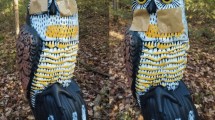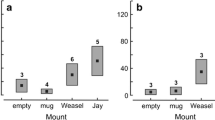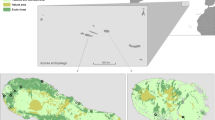Summary
When Thomson's gazelles (Gazella thomsoni) detect stalking predators, such as cheetahs (Acinonyx jubatus) and lions (Panthera leo), they often approach and follow the predator for up to 72 min (average 14 min). Coursing predators are rarely approached. Gazelle groups were more likely to approach cheetahs if the groups were larger, if the vegetation was low, or if the cheetahs came closer to the group. Immature gazelles were more likely to approach than adults, and a higher proportion of group members participated in inspection behaviour in small groups than in large ones. Gazelles approached closer in less risky situations: if they were in larger groups or if the vegetation was low. Inspection behaviour caused cheetahs to move further between rests and between hunting attempts. Approaching cheetahs was risky, particularly for younger gazelles (probability of being killed while inspecting a cheetah was 1 in 5000 approaches for adults and 1 in 417 approaches for half-grown/adolescent gazelles), and the risks were higher than monitoring cheetahs from a distance. The time costs of predator inspection were also considerable (less than 4.2% of daylight time budget), suggesting that the benefits must be substantial to offset these costs. The results suggested that inspection behaviour was multifunctional, causing stalking predators to move out of the vicinity, enabling gazelles to monitor the predators' movements, and providing an opportunity, particularly for younger animals, to learn about predators. By approaching, gazelles also inform predators that they have been detected and alert other gazelles to the predators' presence.
Similar content being viewed by others
References
Albon SD, Mitchell B, Huby BJ, Brown D (1986) Fertility in female red deer Cervus elaphus: the effects of body composition. J Zool London 209:447–460
Altmann SA (1956) Avian mobbing behaviour and predator recognition. Condor 58:241–253
Andersson M, Wiklund CG, Rundgren H (1980) Parental defence of offspring: a model and an example. Anim Behav 28:536–542
Bartecki U, Heymann EW (1987) Field observations of snake-mobbing in a group of saddle-back tamarins, Saguinus fuscicollis nigrifrons. Folia Primatol 48:199–202
Berger J (1979) ‘Predator harassment” as a defensive strategy in ungulates. Am Midland Nat 102:197–199
Bildstein KL (1982) Responses of northern harriers to mobbing passerines. J Field Ornithol 53:7–14
Buitron D (1983) Variability in the responses of black-billed magpies to natural predators. Behaviour 87:209–236
Campbell KLI, Kajuni AR, Huish SA, Mng'ong'o GB (1990) Serengeti ecological monitoring programme (Biennial report, 1988–1989). Serengeti Wildlife Research Centre
Caro TM (1993) Cheetahs of the Serengeti plains: grouping in an asocial species. University of Chicago Press, Chicago (in press)
Clutton-Brock TH, Price OF, Albon SD, Jewell PA (1992) Early development and population fluctuations in Soay sheep. J Anim Ecol 61:381–396
Cox DR (1970) The analysis of binary data. Methuen, London
Csányi V (1985) Ethological analysis of predator avoidance by the paradise fish (Macropodus opercularis L.). I. Recognition and learning of predators. Behaviour 92:227–240
Curio E (1978) The adaptive significance of avian mobbing. I. Teleonomic hypotheses and predictions. Z Tierpsychol 48:175–183
Curio E, Regelmann K (1985) The behavioural dynamics of great tits (Parus major) approaching a predator. Z Tierpsychol 69: 3–18
Curio E, Regelmann K (1986) Predator harassment implies a deadly risk: a reply to Hennessy. Ethology 72:75–78
Curio E, Ernst U, Vieth W (1978a) Cultural transmission of enemy recognition: one function of mobbing. Science 202:899–901
Curio E, Ernst U, Vieth W (1978b) The adaptive significance of avian mobbing. II. Cultural transmission of enemy recognition in blackbirds: effectiveness and some constraints. Z Tierpsychol 48:20–185
Curio E, Klump G, Regelmann K (1983) An antipredator response in the great tit (Parus major): is it tuned to predator risk? Oecologia 60:83–88
Curio E, Regelmann K, Zimmermann U (1985) Brood defence in the great tit (Parus major): the influence of life-history and habitat. Behav Ecol Sociobiol 16:28–273
Dugatkin LA (1990) N-person games and the evolution of co-operation: a model based on predator inspection in fish. J Theor Biol 142:123–135.
Dugatkin LA (1991) Dynamics of the TIT FOR TAT strategy during predator inspection in the guppy (Poecilia reticulata). Behav Ecol Sociobiol 29:127–132
Dugatkin LA (1992) Tendency to inspect predators predicts mortality risk in the guppy (Poecilia reticulata). Behav Ecol 3:124–127
Dugatkin LA, Godin J-GJ (1992) Prey approaching predators: a cost-benefit perspective. Ann Zool Fenn 29:233–252
Fanshawe JH, FitzGibbon CD (1993) Factors influencing the hunting success of a wild dog pack. Anim Behav 45:479–490
FitzGibbon CD (1989) A cost to individuals with reduced vigilance in groups of Thomson's gazelles hunted by cheetahs. Anim Behav 37:508–510
FitzGibbon CD (1990) Antipredator strategies of immature Thomson's gazelles: hiding and the prone response. Anim Behav 40:846–855
FitzGibbon CD, Fanshawe JH (1988) Stotting in Thomson's gazelles: an honest signal of condition. Behav Ecol Sociobiol 23:69–74
Frame GW (1986) Carnivore competition and resource use in the Serengeti ecosystem of Tanzania. PhD thesis, Utah State University, Logan
Harvey PH, Greenwood PJ (1978) Anti-predator defence strategies: some evolutionary problems. In: Krebs JR, Davies NB (eds) Behavioural ecology. Blackwell Scientific, Oxford, pp 129–151
Hoogland JL, Sherman PW (1976) Advantages and disadvantages of bank swallow (Riparia riparia) coloniality. Ecol Monogr 46:33–58
Ishihara M (1987) Effect of mobbing toward predators by the damselfish Pomacentrus coelestis (Pisces: Pomacentridae). J Ethol 5:43–52
Kruuk H (1972) The spotted hyena. Chicago University Press, Chicago
Kruuk H (1976) The biological function of gull's attraction towards predators. Anim Behav 24:146–153
Kruuk H, Turner M (1967) Comparative notes on predation by lion, leopard, cheetah and wild dog in the Serengeti area, East Africa. Mammalia 31:1–27
Licht T (1989) Discriminating between hungry and satiated predators: the responses of guppies (Poecilia reticulata) from high and low predation sites. Ethology 82:238–243
Lipetz VE, Bekoff M (1980) Possible functions of predator harassment in pronghorn antelopes. J Mammal 61:741–743
Magurran AE, Girling SL (1986) Predator model recognition and response habituation in shoaling minnows. Anim Behav 34:510–518
Magurran AE, Higham A (1988) Information transfer across fish shoals under predator threat. Ethology 78:153–158
Magurran AE, Pitcher TJ (1987) Provenance, shoal size and the sociobiology of predator-evasion behaviour in minnow shoals. Proc R Soc London B 229:439–465
Montgomerie RD, Weatherhead PJ (1988) Risks and rewards of nest defence by parental birds. Q Rev Biol 63:167–187
Owings DH, Coss RG (1977) Snake mobbing by California ground squirrels: adaptive variation and ontogeny. Behaviour 62:50–69
Owings DH, Owings SC (1979) Snake-directed behaviour by blacktailed prairie dogs (Cynomys ludovicianus). Z Tierpsychol 49:35–54
Pettifor RA (1990) The effects of avian mobbing on a potential predator, the European kestrel, Falco tinnunculus. Anim Behav 39:821–827
Pitcher TJ (1980) Some ecological consequences of fish school volumes. Freshwater Biol 10:539–544
Pitcher TJ (1986) Functions of shoaling behaviour in teleosts. In: Pitcher TJ (ed) The behaviour of teleost fishes. Croom Helm, Beckenham Kent, pp 294–337
Pitcher TJ, Green D, Magurran AE (1986) Dicing with death: predator inspection behaviour in minnow shoals. J Fish Biol 28:439–448
Poiani A, Yorke M (1989) Predator harassment: more evidence on the deadly risk. Ethology 83:167–169
Robinson, SR (1980) Antipredator behaviour and predator recognition in Belding's ground squirrels. Anim Behav 28:840–852
Rowe MP, Owings DH, (1990) Probing, assessment, and management during interactions between ground squirrels and rattlesnakes. Part I. Risks related to rattlesnake size and body temperature. Ethology 86:237–249
Schaller GB (1972) The Serengeti lion: a study of predator-prey relationships. University of Chicago Press, Chicago
Shedd DH (1982) Seasonal variation and function of mobbing and related antipredator behaviors of the American robin (Turdus migratorius). Auk 99:342–346
Sordahl TA (1990) The risks of avian mobbing and distraction behaviour: an anecdotal review. Wilson Bull 102:349–352
Tamura N (1989) Snake-directed mobbing by the Formosan squirrel Calliosciurus erythraeus thaiwensis. Behav Ecol Sociobiol 24:175–180
Van Orsdal KG (1984) Foraging behaviour and hunting success of lions in Queen Elizabeth National Park, Uganda. Afr J Ecol 22:79–99
Walther FR (1969) Flight behaviour and avoidance of predators in Thomson's gazelle (Gazella thomsoni Guenther 1884). Behaviour 34:184–221
Walther FR (1973) On age class recognition and individual identification of Thomson's gazelle in the field. J S Afr Wildl Manage Assoc 2:9–15
Author information
Authors and Affiliations
Rights and permissions
About this article
Cite this article
FitzGibbon, C.D. The costs and benefits of predator inspection behaviour in Thomson's gazelles. Behav Ecol Sociobiol 34, 139–148 (1994). https://doi.org/10.1007/BF00164184
Received:
Accepted:
Issue Date:
DOI: https://doi.org/10.1007/BF00164184




